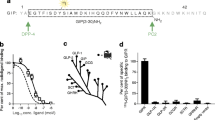Summary
The pharmacokinetic properties of glucagon-like peptide-1(7–36)amide and GLP-1(7–37) were compared. Four beagle dogs received on 4 separate occasions s.c. bolus doses of 50 μg/kg, and 2 min i.v. infusions of 50μg/kg of each peptide. The plasma immunoreactivity of GLP-1 (P-GLP-1-IR) was measured by a sandwich enzyme-linked immunosorbent assay (ELISA). After i.v. infusion, the plasma half-life in the first-phase was 2.1±0.1 and 2.4±0.3 min, in the final-phase 68±6 and 81±3 min, the total plasma clearance 25±3 and 22±4 ml/kg. min, the volume of distribution at steady state 0.16±0.02 and 0.84±0.24 l/kg, and the mean residence time 6.2±0.3 and 36±5 min for GLP-1(7–36)amide and GLP-1(7–37), respectively. After s.c. administration, the maximum plasma concentration was reached after 15±5 and 19±4 min and the absolute bioavailability was 48±7 and 49±13% for GLP-1(7–36)amide and GLP-1(7–37), respectively. P-GLP-1-IR, measured by a radioimmunoassay (RIA), was considerably higher than when measured by ELISA. This discrepancy was due to cross-reactivity with metabolites of the parent peptide. The plasma degradation was studied in vitro in dog plasma at 37°C, and the half-lives were found to be 61±9 and 132±16 min for GLP-1(7–36)amide and GLP-1(7–37), respectively (n=6). Bacitracin inhibited the degradation of both peptides.
Similar content being viewed by others
References
Ørskov C. (1992): Glucagon-like peptide-1, a new hormone of the entero-insular axis. Diabetologica, 35, 701–711.
Ørskov C., Wettergren A., Rabenhøj L., Hoist J.J. (1993): A comparison of the production, secretion and effects of glucagon-like peptide-1(7–36)amide and GLP-1(7–37). Digestion, 54, 382–383.
Mojsov S., Kopczynski M.G., Habener J.F. (1990): Both amidated and nonamidated forms of glucagon-like peptide-1 are synthesized in the rat intestine and pancreas. J. Biol. Chem., 265, 8001–8008.
Buckley D.I., Lundquist P. (1992): Analysis of the degradation of insulinotropin [GLP-1(7–37)] in human plasma and production of degradation resistant analogs. Regul. Pept., 40, 117A.
Deacon C.F., Johnsen A.H., Hoist J.J. (1995): Degradation of glucagon-like peptide-1 by human plasma in vitro yields an N-terminally truncated peptide which is a major endogenous metabolite in vivo. J. Clin. Endocrinol. Metab., 80, 952–957.
Rachman J., Turner R.C. (1995): Drugs on the horizon for treatment of type II diabetes. Diabetic Med., 12, 467–478.
Galloway J.A., Chance R.E. (1994): Improving insulin therapy: achievements and challenges. Horn. Metab. Res., 26, 591–598.
Ørskov C., Wettergren A., Hoist J.J. (1993): Biological effects and metabolic rates of glucagon-like peptide-1(7–36)amide and glucagon-like peptide-1(7–37) in healthy subjects are indistinguishable. Diabetes, 42, 658–661.
Deacon C.F., Nauck M.A., Toft-Nielsen M., Pridal L., Wilims B., Hoist J.J. (1995): Both subcutaneously and intravenously administered glucagon-like peptide-1 are rapidly degraded from the amino terminus in type II diabetic patients and healthy subjects. Diabetes, 44, 1126–1131.
Adelhorst K., Hedegaard B.B., Knudsen L.B., Kirk O. (1994): Structure-activity studies of glucagon-like peptide-1. J. Biol. Chem., 269, 6275–6278.
Pridal L., Ingwersen S.H., Larsen F.S., Hoist J.J., Adelhorst K., Kirk O. (1995): Comparison of sandwich enzyme-linked immunoadsorbent assay and radioimmunoassay for determination of exogenous glucagon-like peptide-1(7–36)amide in plasma. J. Pharm. Biomed. Anal., 13, 841–850.
Hoist J.J., Bersani M, Johnsen A.H., Kofod H., Hartmann B., Ørskov C. (1994). Proglucagon processing in the porcine and human pancreas. J. Biol. Chem., 269, 18827–18833.
Heinzel G., Woloszczak R., Thomann P. (1993): Pharmacokinetic and pharmacodynamic data analysis system for the PC. Topfit 2.0. Stuttgart, Gustav Fischer.
Rowland M., Tozer T.N. (1989): Clinical Pharmacokinetics, Concepts and Applications, 2nd edn. Philadelphia, Lea & Febiger, p. 143.
Knudsen L.B., Pridal L. (1995): Glucagon-like peptide-1(9–36)amide is a major metabolite of glucagon-like peptide-1(7–36)amide after in vivo administration to dogs, and it acts as an antagonist on the pancreatic receptor . Eur. J. Pharmacol. (in press).
Uttenthal L.O., Ghiglione M., Van Delft J., Hermida O.G., Fontela T., Koch C. (1993): A sensitive enzyme-linked immunosorbent assay for glucagon-like peptide-1. Digestion, 54, 395.
Author information
Authors and Affiliations
Rights and permissions
About this article
Cite this article
Pridal, L., Deacon, C.F., Kirk, O. et al. Glucagon-like peptide-1(7–37) has a larger volume of distribution than glucagon-like peptide-1(7–36)amide in dogs and is degraded more quickly in vitro by dog plasma. European Journal of Drug Metabolism and Pharmacokinetics 21, 51–59 (1996). https://doi.org/10.1007/BF03190278
Received:
Issue Date:
DOI: https://doi.org/10.1007/BF03190278




